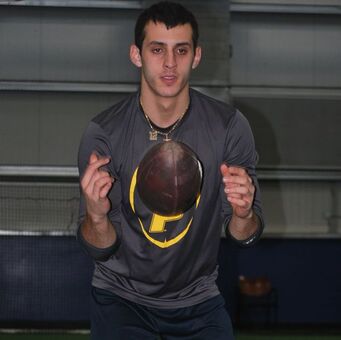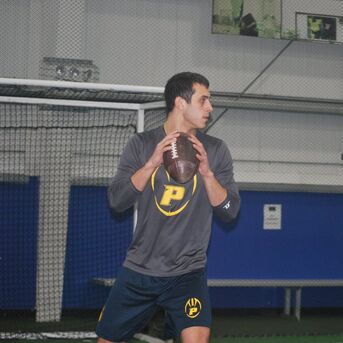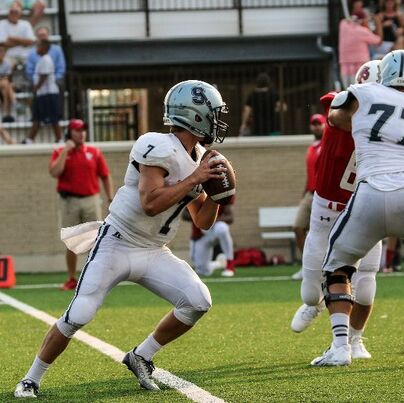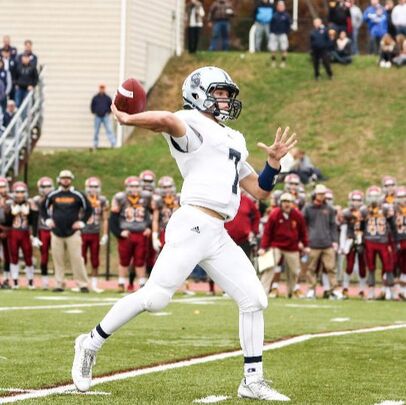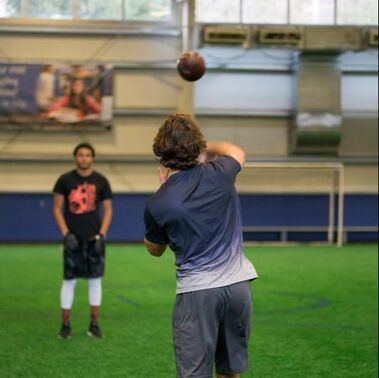Greatness isn't Chance, Greatness is Choice.
Choose Greatness.
Choose Greatness.
COMPREHENSIVE APPROACH
It is crucial to us at the Drayson Quarterback Academy that we create a comprehensive system of development, where we can handle all aspects of quarterback play and progress. This includes:
1 - Biomechanical Integrity
2 - Physical Outputs
3 - Mechanics and Fundamentals
4 - Mental Skills and Performance
5 - Nutrition
We combine that complete approach to development with a commitment to seeing every quarterback as an individual and customizing their path to development to meet their needs and goals.
A COMPLETE SYSTEM OF QB PLAY
A lot of coaches offer tips and drills to help improve performance. That's not what we do. We create a complete system of quarterback play, where our throwing mechanics match our footwork, our footwork matches our pocket fundamentals, our pocket fundamentals are tied to concepts in progressions, and so on. The entire skill set of a quarterback must operate in conjunction with the rest of the skills, there are no components that can be left in a vacuum.
BETTER METHODS, BETTER RESULTS
Practice doesn't make perfect, practice makes permanent. Perfect practice makes perfect. It is our job to enable deep, purposeful repetitions to create valuable and efficient practice time. The means we value "process over product," a phrase we discuss often with our quarterbacks to show the importance of how we do things rather than focusing on short term outcomes.
We ensure that we focus on causes, not symptoms. Many coaches look at the end result of a motion and fail to address the root cause. By being comprehensive, we have many tools at our disposal that allow us to see why a quarterback does something, instead of just telling him to fix it. In doing so, we can empower our quarterbacks through knowledge and give them the ability to self-correct.
We also make sure we engage in directly applicable drills, looking to create as much transfer from drill work to game performance as possible. The position must be played with a clear structure and system of progression on every down. Too many drills by today's coaches (at all levels) are done with the generic aesthetic of the quarterback in mind. However, every drill should have a directly applicable purpose.
Many quarterbacks learn best in different ways. We cover all aspects of the learning process to make sure information is properly internalized. From slow frame film breakdown on mechanics, to drill work using an external stimulus to facilitate change, to whiteboard work, to studying models, we'll put every quarterback in the best position possible to add to their skill set and knowledge base.
We ensure that we focus on causes, not symptoms. Many coaches look at the end result of a motion and fail to address the root cause. By being comprehensive, we have many tools at our disposal that allow us to see why a quarterback does something, instead of just telling him to fix it. In doing so, we can empower our quarterbacks through knowledge and give them the ability to self-correct.
We also make sure we engage in directly applicable drills, looking to create as much transfer from drill work to game performance as possible. The position must be played with a clear structure and system of progression on every down. Too many drills by today's coaches (at all levels) are done with the generic aesthetic of the quarterback in mind. However, every drill should have a directly applicable purpose.
Many quarterbacks learn best in different ways. We cover all aspects of the learning process to make sure information is properly internalized. From slow frame film breakdown on mechanics, to drill work using an external stimulus to facilitate change, to whiteboard work, to studying models, we'll put every quarterback in the best position possible to add to their skill set and knowledge base.
CREATING SOUND, REPEATABLE MECHANICS
There's no one right way to throw a football. Just look at the NFL, and you'll see a variety of approaches, release points, grips, and other variables. That said, there are a few major components that serve as the best model to create consistent accuracy, velocity, and keep an arm healthy. We approach every quarterback with the goal of putting them in a position to be accurate, throw with velocity, and have consistency, and that starts with giving them a good mechanical foundation from which to start.
Landmark 1: The Start PositionWe teach our starting position by focusing on keeping the nose of the football down, on the chest, and the elbows in. This prevents the ball from being exposed to the pass rush, and also puts us in a safer position to begin our throwing motion.
Most common error is a quarterback who has been taught to hold the ball on the shelf, that is, to keep it elevated up near the ear or shoulder, with the elbows out and nose of the ball pointing forwards. When a quarterback does this, he is exposing the ball and predisposing himself to picking the elbow up to start his throwing motion, which can create an impingement at the shoulder and lead to future shoulder and elbow overuse injuries. |
Transition: PullOur "Pull" is characterized by the left foot and hip initiating the forward move, sometimes seen through the lens of the "foot strike," and the right arm and ball moving upwards to prepare to throw.
The most common error during this transition is what we call "wing," where the elbow moves higher than the ball. We want to see the elbow lower than the ball at all times to keep the shoulder in a safe, healthy position, and also prevent other common mechanics issues later in the motion. Functionally, the "Pull" should not actually see the ball move backwards, rather, it should just move towards the Load Position (the next landmark) as the body moves forwards, which gives the appearance that the ball is moving backwards. |
Landmark 2: The Load Position |
Transition: Power Channel |
|
Hitting the Load Position means we have the ball at our 90/90 position, our left foot has hit the ground on our stride, and our hips have begun creating torque towards the target while our shoulders remain down the target line. That separation between hips and shoulders is crucial and comprises what has been called the K-Angle or X-Factor Stretch. This position is where we have loaded all our potential energy, which will be released as we begin the ball's forward movement.
Many players will fail to create separation between the hips and shoulders, limiting the power they load, while others will put their arm in a limited position, most commonly a "tucked" position, where they lack the width to take advantage of their rotational velocity. |
The Power Channel is the transition from the loaded position to our actual release. This is a crucial component, allowing us to transform potential energy into actual velocity and arm talent. In this period, we look to see proper sequencing from the ground up, as the hips drive the motion and create a solid foundation for the shoulders and arm to transfer energy out to the ball, eventually widening the arm angle from the 90/90 at the Loaded Position to our release point.
If at any point a quarterback loses the proper kinetic chain, he will quickly see his velocity and consistency drop. Aligning all the segments of the chain comes very naturally for some, and less so for others, but is crucial for all. |
|
|
Our final landmark position is our pronation from our release point. This starts with the ability to pronate, meaning turn the wrist and hand down and in, as we release the ball. It is this motion that creates a spiral and releases the final segment of the kinetic chain into the throw. For many, pronation is the first portion of the throwing motion they will learn.
The next component of the release point is the actual height and width of the release point. We teach our quarterbacks to release the ball with their forearms vertical, elbows level with their ear, and arm slightly in front of their chest. While we must be adaptable to game variables that can force us to adjust our release point, when it's our choice we want to hit the right spot. Most issues with the release point are caused by having to compensate for issues earlier in the motion. Once we correct the underlying issue, we can correct the release very easily. |
PERFORMANCE, BUILT FROM THE GROUND UP
Footwork is a carefully crafted progression of movements that allow quarterbacks to always be in position to throw from a solid platform and create powerful ground forces. Our quarterbacks aren't taught to simply patter their feet in place for the aesthetic value that comes with that; our guys learn real, game applicable, functional footwork to create timing, consistency, velocity, and accuracy.
Accuracy is generally thought of as an arm talent, but in reality, accuracy is a product first of good footwork. We teach our quarterbacks how to keep their feet "in phase" both in calm times and chaos, and in doing so create accurate passers, who feet allow their arms to function at their potential. By basing our footwork off the concept of in-phase, we give our quarterbacks and tangible structure to operate within and a point of reference throughout all components of a play.
The Quarterback Order to Operations
1. The Drop Tree and Rhythm Throws: The starting point for every quarterback's footwork must be to master the basic drops of his drop tree and have the ability to throw in rhythm. A good offense (and a good quarterback operating that offense) should be able to create easy, rhythm throws as the foundation of the passing game.
2. Hitching Through Progressions to On-Schedule Throws: Once the drop tree and rhythm throws are in place, we develop the ability to hitch through a progression, maintain timing and keeping our feet in phase with our progression, even against pressure.
3. Hitching Through Pressure to Off-Schedule Throws: When the rush becomes too much to evade and stay on schedule with progression, we can look to develop the ability to evade the rush but maintain our pocket demeanor and locate a receiver within the context of play, even if we are off-schedule.
4. Escaping the Pocket to Extend the Play: Eventually, the pocket does not support the quarterback anymore, at which point we'll turn to our 4 escapes, establishing depth and learning to work against pressure to create separation.
MENTAL PERFORMANCE - CALM IN THE CHAOS
Defensive Recognition
We want to make sure our Quarterbacks are the most knowledgeable at their position in the country and give them the tools they need to accurately read a defense consistently. We'll make sure they know how to identify coverages, read the coverage triangle, defeat the blitz, adjust plays based on pre-snap looks, and have a system for reading the defense before every snap. Through knowledge, we can create a calm demeanor on every play.
Reads and Progression
Our Quarterbacks will know how to categorize their passing concepts into different types of reads, isolate the crucial movement keys post-snap, and create a tangible structure for their decision-making process. Too many young Quarterbacks are told "see the field, throw to the open man," instead of learning how to discipline their eyes, manipulate the defense when necessary, and following a structured read tree based on movement keys.
Leadership Skills
The Quarterback must have the leadership skills to be a coach on the field, handle difficult situations with confidence, and motivate his teammates. We'll teach leadership tactics in every session, preaching the lessons that many of the best Quarterbacks learned on their own journey. By leverage Coach Drayson's background as a leadership psychologist, we'll put our guys in a position to be more than an efficient passer - we'll give them the tools they need to be effective leaders and winners.
Mental Profile
Every person has a different mental profile. We create a complete picture of what makes our guys tick by using a thorough mental profile, uncovering whether the player has intrinsic or extrinsic motivation, whether they are process or outcome orientated, whether they lean towards failure avoidance or success seeking, and more. We want our players to have every tool at their disposal, and understanding the way they are wired is crucial, both for their own knowledge and for us to approach our coaching.
We want to make sure our Quarterbacks are the most knowledgeable at their position in the country and give them the tools they need to accurately read a defense consistently. We'll make sure they know how to identify coverages, read the coverage triangle, defeat the blitz, adjust plays based on pre-snap looks, and have a system for reading the defense before every snap. Through knowledge, we can create a calm demeanor on every play.
Reads and Progression
Our Quarterbacks will know how to categorize their passing concepts into different types of reads, isolate the crucial movement keys post-snap, and create a tangible structure for their decision-making process. Too many young Quarterbacks are told "see the field, throw to the open man," instead of learning how to discipline their eyes, manipulate the defense when necessary, and following a structured read tree based on movement keys.
Leadership Skills
The Quarterback must have the leadership skills to be a coach on the field, handle difficult situations with confidence, and motivate his teammates. We'll teach leadership tactics in every session, preaching the lessons that many of the best Quarterbacks learned on their own journey. By leverage Coach Drayson's background as a leadership psychologist, we'll put our guys in a position to be more than an efficient passer - we'll give them the tools they need to be effective leaders and winners.
Mental Profile
Every person has a different mental profile. We create a complete picture of what makes our guys tick by using a thorough mental profile, uncovering whether the player has intrinsic or extrinsic motivation, whether they are process or outcome orientated, whether they lean towards failure avoidance or success seeking, and more. We want our players to have every tool at their disposal, and understanding the way they are wired is crucial, both for their own knowledge and for us to approach our coaching.
A COMPLETE OFF-SEASON PLAN
We structure an off-season into 3 phases, allowing us to create progression through connected skills sets rather than simply trying to address everything at all times. Through intelligent planning comes the greatest progress.
Phase I - Winter: In the Winter, we focus on our core mechanics and getting valuable, deep practice reps to ingrain mechanic changes and adjustments. In many instances, we'll work on individual components in isolation to create a full understanding of the position and make it easier for the quarterback to implement the change. This is a crucial time, as making changes in mechanics takes significant time and repetitions, and these changes must be fully ingrained into the athlete's dominant motor program in order for them to transfer to more game like and live scenarios.
Phase II - Spring: Once the mechanic changes have been ingrained, we move onto more dynamic motions during phase II, looking to apply mechanics changes to more full speed and full skill drills, rather than being broken down into components. This will include an increased focus on footwork and timing, connecting throwing mechanics to our footwork, drops, pocket fundamentals, and other fluid portions of the position.
Phase III - Summer: Our final phase before the season, we will work on scheme specific drills and concepts, looking to attach our mechanics and fundamentals from Phases I and II to the quarterback's offense. We'll work on reads and progressions, film breakdown, defensive recognition, adapting to unusual situations, and other items that help the quarterback to apply his mechanics and fundamentals.
As much as we'd like every quarterback to go through this full off-season plan, we know that schedules simply don't always allow for that, or that some quarterbacks will join part way through an off-season. In those cases, we'll adjust accordingly, attacking the area that is most restricting the quarterback.
Phase I - Winter: In the Winter, we focus on our core mechanics and getting valuable, deep practice reps to ingrain mechanic changes and adjustments. In many instances, we'll work on individual components in isolation to create a full understanding of the position and make it easier for the quarterback to implement the change. This is a crucial time, as making changes in mechanics takes significant time and repetitions, and these changes must be fully ingrained into the athlete's dominant motor program in order for them to transfer to more game like and live scenarios.
Phase II - Spring: Once the mechanic changes have been ingrained, we move onto more dynamic motions during phase II, looking to apply mechanics changes to more full speed and full skill drills, rather than being broken down into components. This will include an increased focus on footwork and timing, connecting throwing mechanics to our footwork, drops, pocket fundamentals, and other fluid portions of the position.
Phase III - Summer: Our final phase before the season, we will work on scheme specific drills and concepts, looking to attach our mechanics and fundamentals from Phases I and II to the quarterback's offense. We'll work on reads and progressions, film breakdown, defensive recognition, adapting to unusual situations, and other items that help the quarterback to apply his mechanics and fundamentals.
As much as we'd like every quarterback to go through this full off-season plan, we know that schedules simply don't always allow for that, or that some quarterbacks will join part way through an off-season. In those cases, we'll adjust accordingly, attacking the area that is most restricting the quarterback.

